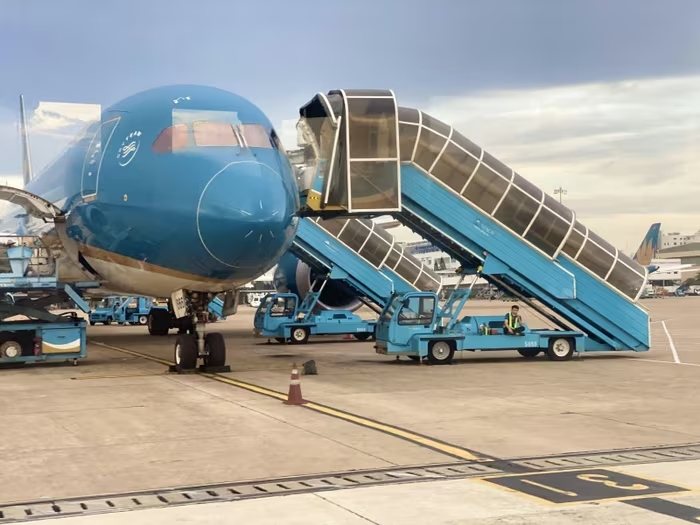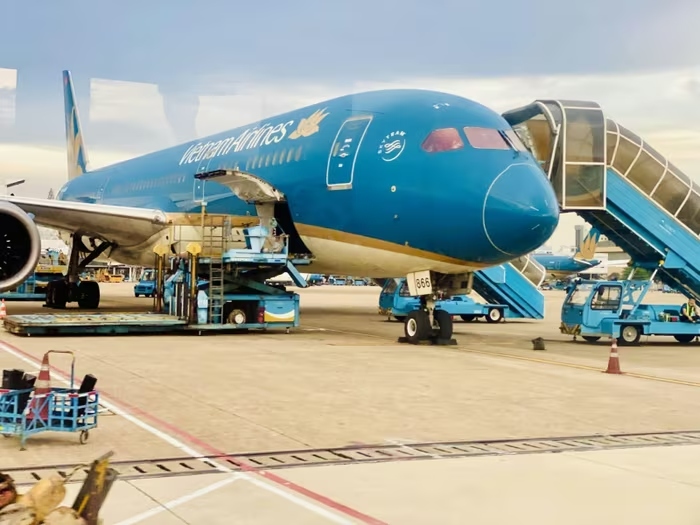Air transport: new driving force for Vietnam's exports
In the global trade picture, East Asia and Southeast Asia are playing the role of “ the world ’s factory ”, with a series of key manufacturing industries such as electronics, textiles, pharmaceuticals, seafood and cross-border e-commerce. This is a group of goods that requires fast, stable transportation and strict quality control - a field where air transport has an absolute advantage over sea or road transport.

Emirates SkyCargo currently maintains nine gateways in the region, with a density of 44 cargo flights per week.
For Vietnam, the strong shift in the global supply chain after the COVID-19 pandemic and the geopolitical context have made our country a new manufacturing destination. Electronics, high-tech, textile and seafood corporations all have great demand for exports to the US, Europe and the Middle East. This is the reason why air freight volume from Vietnam reached 13,873 tons in the 2024-2025 fiscal year, a significant increase compared to the previous period.
Emirates SkyCargo, the cargo division of Emirates, is playing a key role in this. The airline currently operates 44 dedicated freighter aircraft, along with 13 charter flights and 311 passenger flights per week, providing a capacity of over 21,000 tonnes per week to 25 gateways across East and Southeast Asia, including Vietnam.
This is the largest and most diverse network among carriers outside the region, directly supporting the growing export demand from emerging manufacturing hubs such as Vietnam. Emirates SkyCargo currently maintains nine gateways in the region, with a weekly frequency of 44 cargo flights, the highest in its global network.
Notably, in the context of increasingly fierce export competition, Vietnam has entered the group of central economies of the global value chain, where air transport has become a vital link. Accordingly, air transport is also a factor that enhances "speed", an advantage that helps Vietnamese enterprises meet urgent orders, shorten the time to access the consumer market and strengthen trust with partners.
Maintaining a stable trade rhythm by air helps many Vietnamese seafood, fruit, vegetable and electronic component businesses avoid risks from fluctuations in shipping rates or congestion at international ports.
Domestic airlines such as Vietnam Airlines are only operating at a limited level.
However, dependence on foreign carriers also poses a strategic problem. Currently, most of Vietnam's international air transport capacity is in the hands of large airlines from the Middle East, Hong Kong, South Korea or Singapore . Domestic airlines such as Vietnam Airlines, VietJet and Bamboo Airways have only exploited at a limited level, mainly relying on the cargo compartments under the fuselage of passenger aircraft. This shows a large gap if Vietnam wants to be self-sufficient in freight transport.
Logistics infrastructure challenges
To achieve the goal of becoming a regional logistics hub by 2045, Vietnam needs to develop a dedicated cargo fleet, invest in a modern, international-standard logistics system, and have policies to encourage domestic enterprises to participate more deeply in the freight transport sector. Only by proactively developing infrastructure and transport capacity can Vietnam fully exploit its geostrategic potential and reduce its dependence on foreign firms in the global supply chain.
Therefore, not only Emirates, many other international carriers are increasing their presence in Vietnam, turning the market of nearly 100 million people into a "hot spot" for competition in the field of aviation logistics. Specifically, Cathay Pacific Cargo is currently re-operating a dedicated route to Ho Chi Minh City , transporting an average of nearly 2,000 tons of cargo per month from Vietnam.

Only by proactively developing infrastructure and transport capacity can Vietnam fully exploit its potential.
Notably, cargo revenue from Vietnam accounts for more than 40% of Cathay’s total cargo revenue in Southeast Asia, demonstrating the special attractiveness of this market. The main items that Cathay transports include mobile phones, garments, tuna and tropical fruits - groups of goods that need to be refrigerated and transported quickly to ensure quality.
Meanwhile, Korean Air and Vietnam Airlines have just signed a Memorandum of Understanding (MoU) on cargo transport cooperation, with Long Thanh airport expected to be the transit hub. This is a strategic move, as Long Thanh is not only expected to become the most modern international airport in Vietnam but also to compete with leading regional logistics centers such as Singapore Changi or Bangkok Suvarnabhumi. If this cooperation is implemented on schedule, it will help Vietnamese goods connect directly to distant markets such as the US and Europe, reducing transit time and logistics costs.
However, fierce competition also puts great pressure on domestic infrastructure. Existing airports such as Noi Bai and Tan Son Nhat are already overloaded with both passengers and cargo. The capacity of cold storage, quarantine warehouses, and logistics areas in airports is still limited, unable to meet the growth rate of exports. Without synchronous investment, Vietnam is likely to fall into a "bottleneck" situation, despite the large demand and strong interest from international airlines.

Korean Air and Vietnam Airlines have just signed a Memorandum of Understanding (MoU) on cargo transport cooperation to enhance competitiveness.
In addition to infrastructure, institutional factors and human resources are also challenges. Customs procedures, electronic customs clearance, and quarantine and inspection regulations are often complicated, causing delays. High-quality logistics human resources, especially in aviation supply chain operations management, are still in short supply. This may reduce the ability to take advantage of the wave of global supply chain shifts.
In the global picture, the participation of major airlines such as Emirates, Cathay or Korean Air can be considered a “lever” to promote Vietnam’s aviation logistics. However, to take advantage of this, Vietnam needs to synchronize its strategy: Speed up the progress of Long Thanh, modernize warehouses at Noi Bai and Tan Son Nhat; encourage investment in logistics centers associated with international airports and reform procedures to facilitate the rapid circulation of goods. Only then can Vietnam turn its geographical advantage in the heart of Southeast Asia, close to international shipping routes, into a “hard power” in the global supply chain.